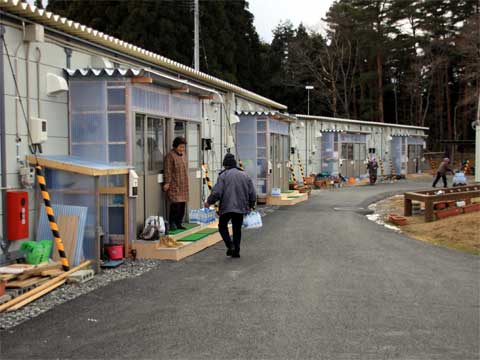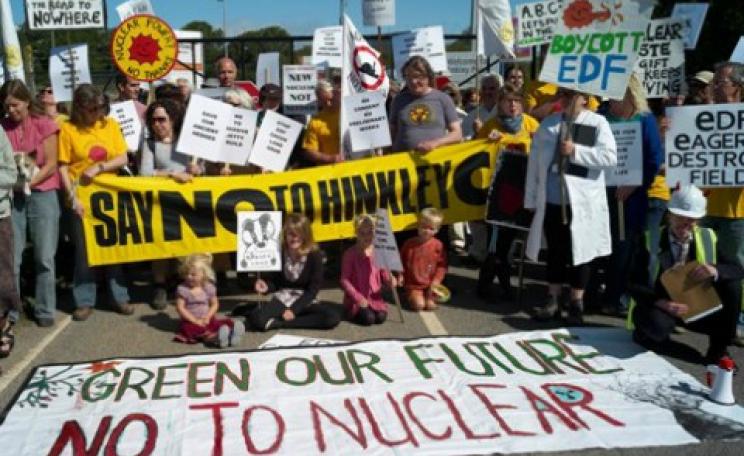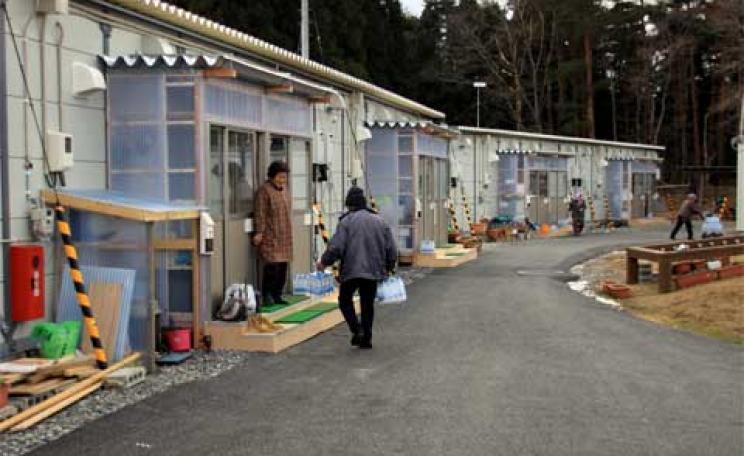It was tea, biscuits and polite exchanges inside the county courthouse in the Cumbrian cathedral town of Carlisle, but the conversation was entirely nuclear. A small group of community members had come to this drop-in consultation to ‘have their say' on whether or not an underground nuclear waste repository should be built at an as yet unchosen site somewhere in West Cumbria. Large display posters were hung up outlining the safety, geology and environmental issues surrounding deep repository - the government's preferred long-term solution to managing its store of 631,000 cubic metres of intermediate and high level nuclear waste.
County officials, a geologist and representatives from DECC and the Nuclear Decommissioning Authority (NDA), were there, responding to questions ranging from ‘how do we know it's safe?', ‘how will it impact Lake District tourism?' to ‘why us?'.
On this frosty February afternoon, as on others over the past few months, at town halls, churches and arts centres across West Cumbria - from Kendal, to Penrith, to Cockermouth - citizens have had the chance to express their views, but whether they have been won over to the idea, and if not, to what extent their concerns are taken on board, remains to be seen.
‘Cumbrians have a pretty fair knowledge of the impact of nuclear, most people have had constructive comments - either in favour or against -but we won't really know until we've done a proper analysis of results- including an Ipsos Mori poll of well over 1,000 people,' says Tim Knowles, chairman of the West Cumbria Managing Radioactive Waste Safely (MRWS) Partnership, which includes government, tourism, farming and other representatives set up to manage the community consultation.
 The government, fearful of pushing a top-down approach, adopted the principle of ‘voluntarism' and in 2008 appealed to communities to find a long-term home for the country's nuclear waste - the majority of it now above ground at Sellafield. In the whole country - only two counties expressed an interest: Allerdale and neighbouring Copeland (home to Sellafield) as well as the umbrella Cumbria Borough Council.
The government, fearful of pushing a top-down approach, adopted the principle of ‘voluntarism' and in 2008 appealed to communities to find a long-term home for the country's nuclear waste - the majority of it now above ground at Sellafield. In the whole country - only two counties expressed an interest: Allerdale and neighbouring Copeland (home to Sellafield) as well as the umbrella Cumbria Borough Council.
Integral to the voluntarism principle is that the communities say they want the repository. So following the drop in consultations, a phone poll will take place next month and based on this, the three councils will make a decision about whether to enter the siting process.
‘We are at the first stage in equipping Cumbrians with sufficient information. What's important is that the local authorities will have the veto right up to the start of construction - that is a decade away,' says Tim Knowles.
Naysayers gather
Some 30 miles south, at an Eco Centre at the Cockermouth School, that night a crowd streamed in to hear a talk by Professor David Smythe organised by Save Our Lake District (SOLD). In contrast to the community ‘drop in' session, most of the estimated 200 who had come were already fiercely against the nuclear waste repository.
‘Voluntarism', for them refers to a PR offensive geared to pushing ahead plans to bury the waste deep underground in an area where the population is ‘nuclear compliant' yet the geology entirely unsuitable.
Professor Smythe, an independent geologist, who is actively campaigning against housing a waste repository anywhere in West Cumbria says that appropriate geology should be the overriding issue, not voluntarism. ‘They are now trying to get it in through the back door and say, ‘"well the locals want it" and forget all about the geology,' he says.
 Smythe, a former geophysics professor at the University of Glasgow who also worked on the British Geological Survey's initial Nirex Planning Inquiry in the early 1990s, was the first to design and run a 3-dimensional scale of Longlands Farm - a site about two miles from Sellafield- initially chosen out of a potential 437 sites in the whole of Britain to house the underground nuclear waste repository. ‘It horrified me. You could see the fault lines', he says.
Smythe, a former geophysics professor at the University of Glasgow who also worked on the British Geological Survey's initial Nirex Planning Inquiry in the early 1990s, was the first to design and run a 3-dimensional scale of Longlands Farm - a site about two miles from Sellafield- initially chosen out of a potential 437 sites in the whole of Britain to house the underground nuclear waste repository. ‘It horrified me. You could see the fault lines', he says.
The Longlands Farm site was eventually dropped by then environment secretary John Gummer, only after £400 million was spent on drilling exploratory boreholes.
Smythe's PowerPoint presentation was rife with technical diagrams, going through Cumbria's geology district by district...from sandstone and limestone, to Eskdale granite and Mercia mudstone. Smythe says he is not against geological disposal in principle. ‘Geology is the most important barrier keeping waste leaking out,' he says pointing out that the area's ‘severe topography' - high mountains and fast and unpredictable water flow make it unsuitable.
Disagreement over geology
 Already, about 25 per cent of the area has been deemed unsuitable (seen in red on the map left) by a British Geological Society survey last year for reasons of coal or iron ore deposits, which future generations may decide to exploit - putting them in danger of coming across a still radioactive nuclear waste dump. Yet the Longlands Farm site, on these criteria, could still be suitable and has not been excluded.
Already, about 25 per cent of the area has been deemed unsuitable (seen in red on the map left) by a British Geological Society survey last year for reasons of coal or iron ore deposits, which future generations may decide to exploit - putting them in danger of coming across a still radioactive nuclear waste dump. Yet the Longlands Farm site, on these criteria, could still be suitable and has not been excluded.
‘The rest' says Jeremy Dearlove, a geologist employed by MRWS, ‘is not necessarily suitable, but nor is it necessarily unsuitable'. His views echo those of the government's Committee on Radioactive Waste Management (CoRWM), which has said there is, ‘no credible scientific case to support the contention that all of West Cumbria is geologically unsuitable'.
Smythe's argument is that international guidelines dictate that you hone in on geology before deciding on a site. He says the UK's current approach has allowed the Sellafield area to rise ‘Phoenix like' as ‘potentially suitable'.
In March, a telephone opinion poll will give 1,000 people in both Allerdale and Copeland Borough Councils a choice of ‘yes', ‘no', or, ‘I don't know' to the question of whether they want to go forward. This will guide the votes of the district councils of Allerdale and Copeland and Cumbria County Council.
Providing the 'yeses' are more than the 'nos', the process will go forward to desk-based studies and geological investigations to find a suitable site.
'But the research has been done. I've done it,' says Smythe. 'Once the drilling starts you are at the point of no return,' he says.
In an area already dependent on the nuclear industry, a waste repository - which would represent the country's largest engineering project with the amount of rock excavated similar to what was removed during the building of the Channel Tunnel - could be a boon, including job creation and a government benefits package. The repository, at up to 1 kilometre underground, would cover an area of up to 25 square kilometres and store enough intermediate and high level waste to fill the Royal Albert Hall up to 11 times.
Marianne Birkby of campaign group Radiation Free Lakeland, says ‘Unless people wake up to the enormity of this project we are stuffed'.
What about the next generation?
Knowles, Chairman of the MRWS, says ethics has played a major role. ‘Opinion polls showed that Cumbrians felt this generation had the responsibility for sorting out this mess. It was inappropriate to leave this material in this situation. ‘
The future generations argument - and the ethics of leaving a legacy of nuclear waste - goes both ways.
David Smythe says, ‘This is not just about our children and our children's children. You're asking so much of so many generations in the future to look after this stuff. To say nothing of thousands of generations.'
In the end, what it will almost clearly do is pave the way for the government to go ahead with new nuclear build, as it will, at least in theory, be the first time the nuclear waste issue has been 'solved'.
Further information:
West Cumbria Managing Radioactive Waste Safely Partnership
Save our Lake District: Don't Dump Cumbria!
| READ MORE... | |
 |
NEWS ANALYSIS Nuclear special New study links childhood leukaemia to nuclear power plant radiation The UK government's scientific advisory group found no link between childhood leukaemia and proximity to nuclear power plants, but German and French research has found an alarming doubling of risk. Matilda Lee reports |
 |
COMMENT Nuclear special Fukushima: the social impact of a nuclear disaster The earthquake and nuclear meltdown in Japan last year compounded pre-existing issues like falling birth rates, fragmented families and shrinking communities. What does the future hold? |
 |
COMMENT Nuclear special Campaigners say no to nuclear new build at Hinkley Point Campaign group South-West Against Nuclear want to stop the government's plans for a 'nuclear renaissance' beginning in Hinkley Point in Somerset. Nuclear, activists say, is plagued by problems from beginning to end |
 |
NEWS ANALYSIS Glencore faces questions over controversial DRC mine sales Moves by unknown shell companies to control lucrative natural resources may have cost Democratic Republic of Congo $1 billion in lost revenue, as UK-listed mining company Glencore under pressure to explain deals |
 |
HOW TO MAKE A DIFFERENCE Film exposes the tragedy of pirate fishing in Sierra Leone A new Al Jazeera documentary follows reporter Juliana Ruhfud and producer Orlando von Einsiedel as they investigate Sierra Leone's multi-million dollar illegal fishing trade |








